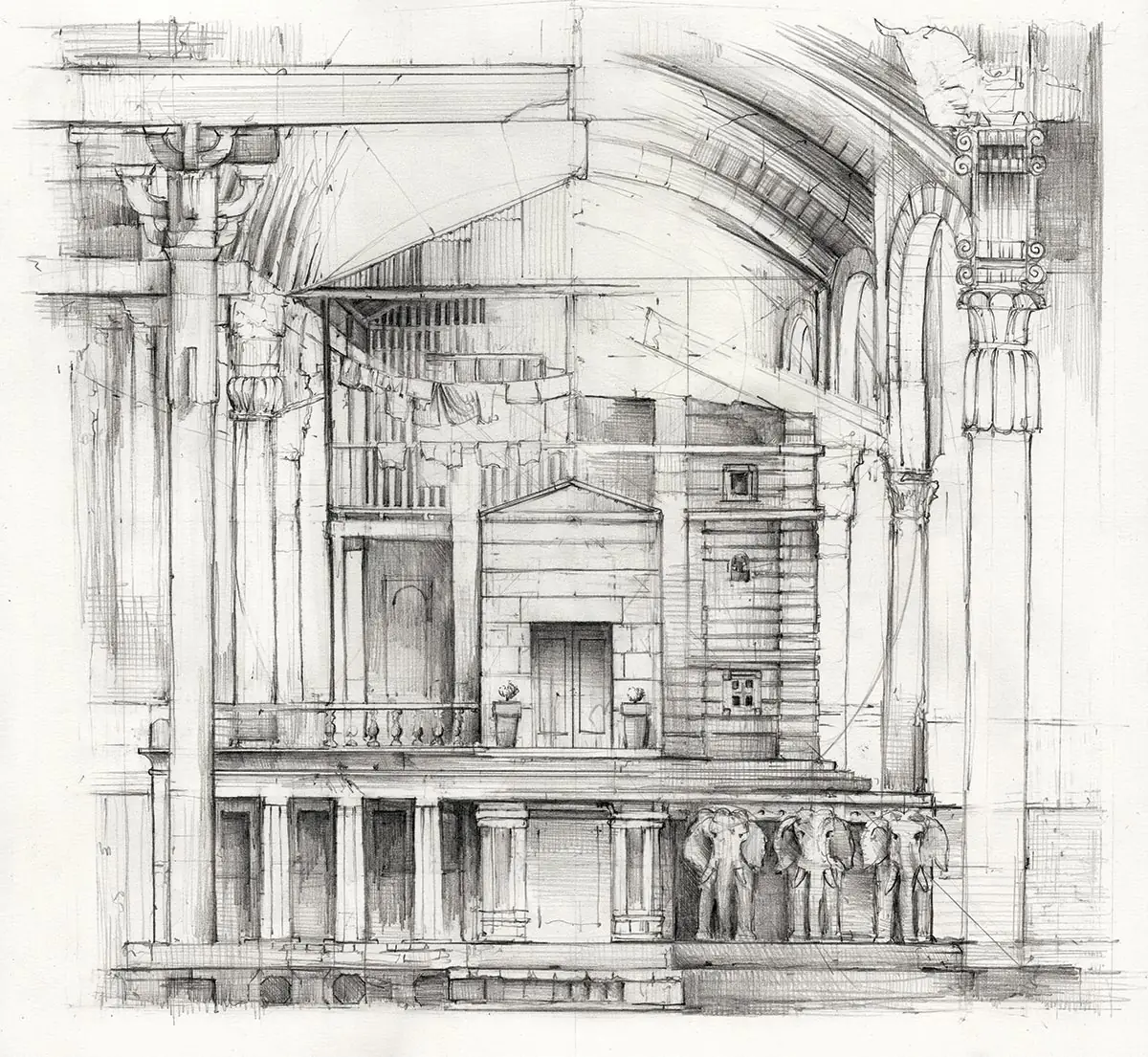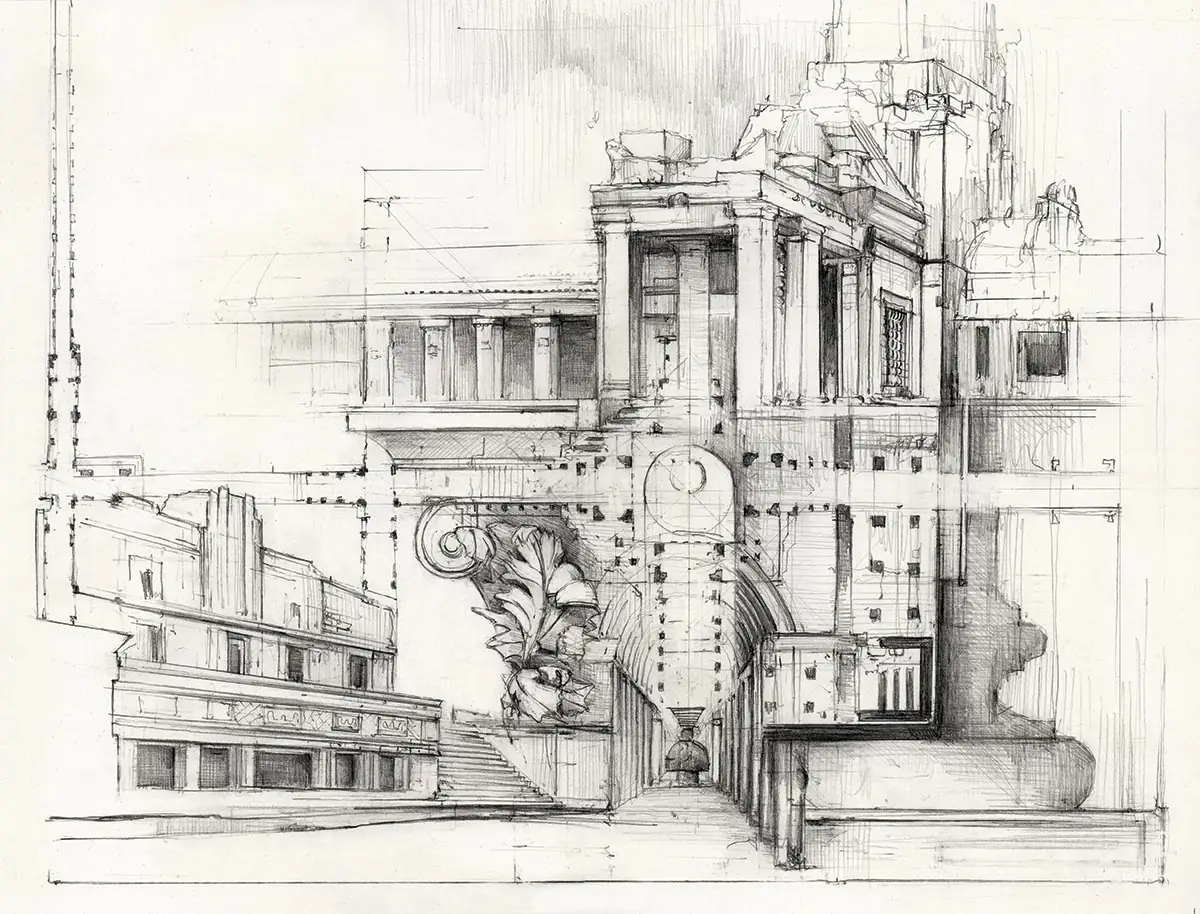What comes to mind when we hear the words classical architecture?
The answer to that question is often embarrassingly narrow. The Parthenon and Pantheon are still there, of course, even if the distinction between them is less vivid than it used to be. We may still acknowledge, in private conversation, the value of a shared canon, even if we are less sure than we were about what might legitimately be included. And at certain moments—during presidential inaugurations, perhaps—we still honor classical commitments to a building culture that scans a longer horizon. But, increasingly, our portrait of the classical takes upon itself the nature of caricature, and—to paraphrase a recent description—we learn that, above all else, classical architecture represents state or capital power, and is associated with historical European values.

Illustration © Jerome Tryon, click to enlarge.
These characterizations—the entanglement with power and the history of Eurocentrism—are commonplace today, nowhere more so than among students of architecture. Whether they are entirely true is largely beside the point. If they are believed to be true, they are likely to become true. If, upon hearing the words “classical architecture,” the imagination supplies images of, say, perfectly proportioned palazzi for acquisitive Medici financiers, symmetrical shrines to social superiority, symbols of power imposed upon victims of colonial despotism, or gargantuan monuments to a new world order centered on the Third Reich, then subsequent encounters with the classical are interpreted accordingly.
And the language is abandoned to its stereotypes. Down-market demagogues reach for the classical in hopes of reinforcing the facade of legitimate authority. The scandalously wealthy agonize briefly over the staggering cost of high modernist austerity before commissioning the high classicism of carefully crafted Corinthian. Race supremacists pose for photographs in front of the nearest available white marble portico. And, along the way, thousands of urban public schools and libraries become advertisements for exclusion, millions of modestly detailed front porches become monuments to privilege, and the entire architecture of America’s democracy becomes a symbol of state and capital power aligned with historical European values.
This might be a problem.
After all, this country’s classical legacy is unlikely to vanish any time soon. What is more, those representatives of the profession who still consider themselves committed classicists, and whose work is (let us admit it) not so frequently illustrated in mainline architectural magazines, are unlikely to deny service to their interested clients. The practice of classical architecture is unlikely to bring to a voluntary close its long and complex history. On the contrary: it appears to be enjoying a renaissance of sorts among enthusiasts who plumb its depths for a welcome contrast to the banality of our more typical forms of practice. They note that classical pedagogy may have been banished for much of the past century, but that this represents a mere blip on the trajectory of the tradition. They note also that the modernist pedagogy that replaced it did not always prove immune to the blandishments of state or capital power—or for that matter, quick to diversify its European values.

Illustration © Jerome Tryon
Not only may it prove difficult to demolish the nation’s classical heritage; it may not even be possible to stamp out the lingering inclination, among architects, to reconstruct the strict austerity of Georgian windows, to trace the licentious curves of Ionic base profiles, or to foliate ornamental details with the curling leaves of Acanthus mollis (a species native to territories including northern Africa and Asia Minor, but tolerant of a wide range of soils). On the other hand, it might just be possible to remind ourselves that classical architecture has not always represented state or capital power, and that it has not always been identified with historical European values.
It would be nice, in fact, if somewhere near the top of that list of mental precedents we might recall those elements of classical history that are insistently not Eurocentric, that are not obviously aligned with capital, or that resist the predictable narratives of state power.
These could include early precedents on the banks of the Nile, where some of the oldest classical forms can be found carved into the rock of Africa’s continental mass, or lingering echoes among the reed houses of the dwindling population of Iraq’s Marsh Arabs. After all, what we think of as classical can best be understood within a larger family of architectures that share striking family resemblances. We could note the obvious debt to the ornamental traditions of the Middle East or sympathies with the surviving polychromy of shophouses in Singapore’s Little India, arguably offering today’s closest approximation to the vivid colors of ancient Greco-Roman practice. We could even observe the striking similarities to the trabeated forms of what are sometimes described as “classical Chinese” courtyard homes—not to mention the uncanny correspondences to the underlying formal structures of pre-Columbian architectures. These examples argue with striking eloquence in favor of a common humanity and against an attitude of tribalism.
Turning into the mainstream of classical form, we might note that the history of the classical cannot be told without reference to medieval churches carved out of the geology of Ethiopia long before classical enthusiasms gripped the ecclesiastical authorities of northern Europe. We might, for that matter, recall those elements of classical architecture’s most predictably European canon that are scaled precisely to the lives of the defenseless—like the small framed opening at the very far end of the portico of Brunelleschi’s hospital in Florence. Drawing on more recent memories, we might pay attention to Kabul’s Darul Aman Palace, which owes a lesser debt to its imported architects than to its region’s histories, its local builders, and, especially, the restorers who made of it a monument to the short-lived reconstructive efforts of Afghanistan’s women.
We could note, with both despair and optimism, that significance can change over time. We could even note those places where Nazism’s classical affectations have been reappropriated by subsequent generations, turning the glorification of hatred into a more enduring celebration of exactly that which the party sought to eradicate—witness Mel Bochner’s Joys of Yiddish now permanently inscribed onto the entablature of what was once Munich’s House of German Art. Or we could dwell on classical architecture’s capacity to serve the interests of the poor, the weak, and the vulnerable: the gloriously elaborate facades of early 20th-century tenements offering dignity for immigrants to America, the outrageously colorful interiors designed by the indigenous populations of the Andes, the classical confections built by the Roma of eastern Europe—or the hundreds of thousands of lovingly crafted funerary monuments dedicated to individual lives, some of them very small, or irreducibly simple, like the Malmström and Rettig mausolea by Lewerentz and Asplund.
We could stand to pay attention to some of the earliest examples of this country’s African American built legacy, often constructed with limited means but immeasurable grace—a task for which the classical is strikingly well equipped. We should recall those monuments that have taken on significance for their roles in the history of civil rights—roles made possible precisely by their classical monumentality: the Lincoln Memorial as backdrop to singer Marian Anderson’s performance, or New Haven’s County Courthouse as backdrop to Black Panther advocacy. We should also note those relics of colonial-era architecture that have become landmarks of independence, finding their ways to new identities and new publics—Chinese characters overlaid onto Trajanic letterforms, just as the statue supported by Trajan’s Column was itself supplanted long ago by its antithesis.
We could tell the story of the classical as a form of practice that learned to communicate not only through size but also through the smallest of details, disposed with infinite care, moulding profiles turning the simplest classical facade into a living tableau of light and shadow, shifting as the sun god works his way across the heavens.
This is an architecture that cannot be constrained by capital or controlled by national borders, and that does not proclaim exclusive allegiance to historical European values. It can symbolize not only power but also restraint—the restraint more characteristic of societies that did not aspire to dominate the natural order with the nonchalance that has proved so disastrous to our recent history. It is the story of a form of practice that can draw on a posture of humility toward its past, while still recognizing the need not only to respect but also to repair, to rebuild, and to reimagine. The challenge is ultimately one of expanding the public imagination. This is, for all of us, a design challenge.





Post a comment to this article
Report Abusive Comment